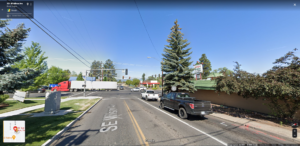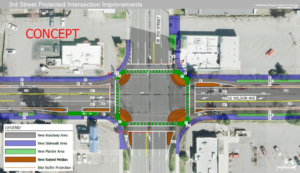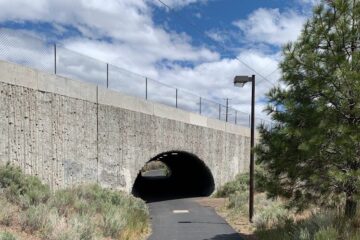
screen shot capture of image of 3rd and Wilson before the signal modification. Bike lanes for east-west biking – coming soon!
The City of Bend will close the bike lane gap and make it easier for everyone to get through the busy 3rd and Wilson traffic signal. As part of the Wilson Corridor project a protected intersection format will be used. This layout uses a setback approach for vehicle stop bars so drivers can more readily see anyone on the parallel crosswalks and in the parallel bike lanes. It eliminates the need to look over shoulders to be able to see everyone. It keeps everyone in the natural cone of vision so we don’t have to use our peripheral vision (which fades as we age; about every decade we lose 1 to 3 degrees of peripheral vision).
The layout and position of crosswalks for people bike riding and walking reduces the crosswalk distance, which in turn saves on green time and allows the signal to operate more efficiently while serving more people.
Protected intersections cut traffic crashes for all users. The impact of increasing sight lines can reduce crashes 48%, while having the bike and pedestrian moved up can mimic the safety crash reduction associated with a leading bike interval and leading pedestrian interval at the traffic signal. LBI and LPI reduce crashes 37%.
KTVZ recently wrote a small article about the project.
Here is another article about protected intersections by a local engineering firm. More and more consulting firms are bringing their expertise to bear as City’s work toward zero injury and fatal crashes and protected intersections are just one more tool in the toolbox to do so.

Screenshot of the concept plan for 3rd and Wilson protected intersection.


0 Comments